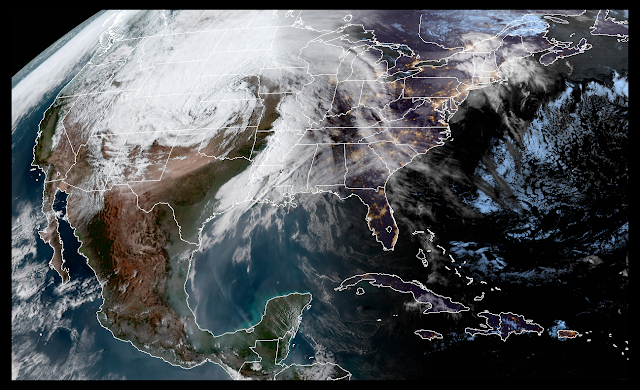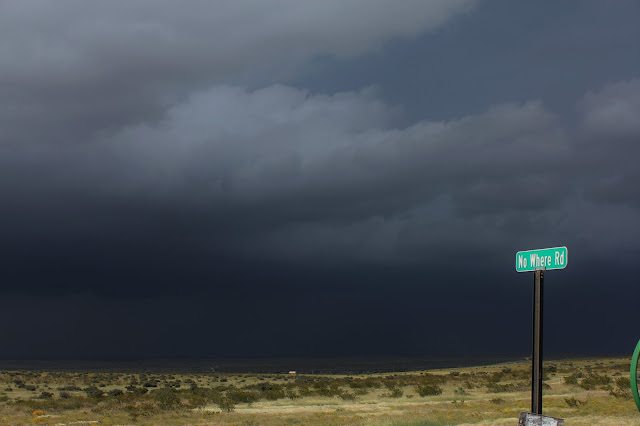High Wind Event March 13th 2019.
March 13th, 2019.
A massive dust storm developed in response to Wednesday's high winds. This huge cloud of blowing dust stretched northeastward from northern Mexico across southern and southeastern New Mexico, West Texas, and into Oklahoma and Kansas.
March 14th, 2019.
Courtesy Of Jason Laney
Cloudcroft, New Mexico.
Thanks to #Cloudcroft Fire Dept for helping with our damage survey. Here is one of the firefighters putting the drone in the air. @NWSElPaso @wx_Jpeg
March 17th, 2019
Near Cloudcroft, New Mexico.
Quote- "Sunday was a productive day for line crews working on the outage. The Sac Peak line was re-energized restoring service to 90% of Timberon, along with Aspen Meadows, Aspen Groove, Bug Scuffle, Benson Ridge, Alamo Peak and Sunspot.
If you still do not have electricity, please report the outage by calling 1-800-548-4660.
After working 16 hour days since the wind storm, crews are exhausted but will return Monday morning to finish making repairs to lines feeding those still without service in Cloudcroft, Timberon and Long Ridge."
March 13th, 2019.
Roswell, New Mexico.
(March 13th, 2019).
High Wind Event March 12-13th, 2019
National Weather Service Midland/Odessa
Despite West Texas and Southeast New Mexico being known for their breezy
conditions in late-winter/early-spring, an anomalous wind event transpired across
the Southern High Plains during the evening March 12th
, and through the morning
and afternoon of March 13th, 2019. The setup was historical in many facets with
areas over the Central High Plains experiencing wide spread blizzard conditions,
severe weather, high wind damage, and multiple site surface low pressure
records broken over the storms life cycle.
What Happened? A strong storm system over the Western US strengthened
over the course of a few days, leading to one of the highest impact weather
events across the Central and Southern Plains in recorded history. High winds
were common for a large chunk of the Rockies and the Southern Plains with
severe blizzard conditions over Eastern Colorado, Wyoming, and the Dakotas. In
West Texas and Southeast New Mexico, winds were the story, with persistent
wind gusts in excess of 60 mph in many locations the night of March 12th
, and
throughout the day of March 13th
.
High Wind Warnings were issued in
anticipation of this significant high wind event. Winds easily reached these
significant thresholds across the region.
For more on the meteorological evolution of the historical storm system, please
refer to the Meteorological Synopsis below.
Meteorological Synopsis: On the morning of March 13th, a potent, negatively
tilted upper-trough was traversing the Central Rockies with a rapidly developing
surface cyclone over the lee side of the Continental Divide in Southeastern
Colorado.
At the base of the trough, a very strong 300mb jet streak extended back
across the Four Corners region and into the West Texas, Southeast NM High Plains.
Through the course of the day, the surface low over Southeastern Colorado
exhibited rapid surface cyclogenesis with intense pressure falls of more than
2mb/hr for several hours between 12z March 13th and 0z March 14th. The
combination of the intense pressure falls and a coupled jet streak over the
Southern Plains culminated in a very tight pressure gradient with deep mixing
potential for strong winds to the surface.
Strong wind gusts began from west to
east with Southeast NM and the adjacent Guadalupe Mountains across Texas
experiencing a sharp increase in surface wind gusts just after 14z March 13th. As
the day unfolded, deep mixing with ample sunshine led to winds mixing efficiently
to 700mb where 60 to 70 knot winds were positioned through the course of the
afternoon. Damaging wind gusts of 60-80 mph were observed across the Southeast
NM Plains and the Permian Basin with gusts of 90+ mph across the Guadalupe
Mountains. The strongest recorded wind gust of 103 mph was measured at Pine
Springs, TX from the local Guadalupe National Park Mesonet at 1:09 pm CDT. Winds
slowly decayed around sunset, but windy conditions prevailed for several hours
after as the local pressure gradient was slow to lift while the storm progressed to
the northeast across Kansas and Nebraska.
Wind Reports: Below is a bulleted list of local wind reports/observations taken
during the course of the event on March 12th
- 13th.*
62 mph – Presidio, TX Presidio County; Presidio ASOS (8:35 pm CDT 3/12)
63 mph – Panther Junction, TX Brewster County; Panther Junction RAWS (12:38
am CDT)
64 mph – Carlsbad, NM Eddy County ;
Carlsbad ASOS (10:56 am CDT)
70 mph – 17 W Orla, TX Culberson County; Trained Spotter (11:51 am CDT)
77 mph – Pine Springs, TX Culberson County; Guadalupe Pass ASOS (11:51 am
CDT)
63 mph – Midland, TX Midland County; Midland ASOS (12:18 pm CDT)
60 mph – Tarzan, TX Martin County; 2 WNW Tarzan Mesonet (12:56 pm CDT)
103 mph – Pine Springs, TX Culberson County; Pine Springs Mesonet (1:09 pm
CDT)
66 mph – Artesia, NM Eddy County; Artesia AWOS (1:55 pm CDT)
60 mph – Lamesa, TX Dawson County; Lamesa AWOS (2:15 pm CDT)
65 mph – Seagraves, TX Gaines County; 1 SW Seagraves Mesonet (2:35 pm CDT)
58 mph – Snyder, TX Scurry County; Snyder AWOS (2:55 pm CDT)
66 mph – Welch, TX Dawson County; Welch Mesonet (3:21 pm CDT)
74 mph – 7 NW Maljamar, NM Eddy County; Caprock RAWS (3:40 pm CDT)
73 mph – Tatum, NM Lea County; 2 SW Tatum Mesonet (3:40 pm CDT)
66 mph – Andrews, TX Andrews County; 2 E Andrews Mesonet (4:20 pm CDT)
98 mph – 3 NNW Pine Springs, TX Culberson County; Guadalupe Bowl RAWS
(5:38 pm CDT)
67 mph – Hobbs, NM Lea County; Hobbs AWOS (6:50 pm CDT)
* Wind events listed in chronological order of occurrence
Summary: Strong winds were experienced over a large portion of the NWS
Midland forecast areas with winds over 60 mph observed for several locales. The
storm itself was a true testament to the power of rapidly developing surface
cyclones with impacts from this system stretching across the Rockies and the entire
Central US. The 103 mph observed wind at Pine Springs Mesonet is in the top
reported wind gust from anywhere in the United States during the storms life cycle.
This event will go down as one of the top non-thunderstorm wind events in the
West Texas, Southeast New Mexico corridor.
(March 13th, 2019).
Overview…
Strong westerly winds developed just after sunrise across the higher terrain of the Sacramento
Mountains in Otero county. Sustained winds from the west of 60 to 70 mph with much higher
gusts persisted through most of the day. By 11 AM the Village of Cloudcroft lost all power and
would remain without power for more than 24 hours. Hundreds of ponderosa pines were
either uprooted or snapped within the Village of Cloudcroft resulting in damage to 30
structures, 10 vehicles, and completely blocking 15 roads. Across the entire area surrounding
Cloudcroft it is estimated that more than 1000 trees were either snapped or uprooted.
Location 1: 11:10 AM
Estimated Max Wind Speed: 107 MPH
A total of three large trees fell on this property. The largest measured approximately 4 feet in
diameter at it’s base. The estimated wind gust of 107 MPH snapped this tree completely at it’s
base, with the tree falling onto the home. Shortly thereafter another large tree across the
street was uprooted and also fell into the home. Finally, a third tree in the yard next door was
uprooted and fell on a car parked next to the home. In addition, several power lines came
down as a nearby utility pole was also snapped (likely by a falling tree).
Location 2: 11:40 AM
Estimated Max Wind Speed: 90 MPH
A nearly 100’ tall ponderosa pine with a trunk measuring a little more than 2 feet in diameter
was uprooted in the back yard of this home, falling directly on the roof. Upon impact, the trunk
of the tree snapped in half with the top portion of the tree landing in the front yard.
Location 3: 11:52 AM
Estimated Max Wind Speed: 94 MPH
Two separate trees came crashing down on this residence in southern parts of Cloudcroft. One
tree was uprooted, falling across the front deck of the home and crushing a red Porsche parked
in front of the home. A second tree, approximately 2 feet in diameter snapped in half, falling on
a truck that was parked next to the house.
Location 4: 11:53 AM
Estimated Max Wind Speed: 101 MPH
A very tall ponderosa pine with a trunk diameter of almost 3 feet completely snapped just
above its base, allowing the entire tree to fall onto the front of a two-story house. The max
wind gust here was estimated to be around 101 MPH. This house is actually located just next
door to location 2 where a tree was uprooted by a 90 MPH wind gust less than 15 minutes
earlier.
Location 5: 3:20 PM
Estimated Max Wind Speed: 94 MPH
Two trees fell on this property just south of Highway 82. The first was uprooted and fell across
the front yard, narrowly missing this house. However, a second tree from the next-door
neighbors back yard also was uprooted and fell directly on the home, puncturing a hole in the
bedroom ceiling.
Survey Summary…
This damage survey was conducted in the Village of Cloudcroft in Otero county following public
reports of over 100 MPH wind gusts and reports of extensive damage within Cloudcroft and
nearby areas. Extensive tree damage was observed including both uprooted ponderosa pines
as well as pines snapped either at their bases or midsections. The Cloudcroft Fire Department
escorted three meteorologists from NWS El Paso to multiple locations where both tree and
property damage were located. Wind speed estimates based on the damage done to these
hardwood trees suggested an extended period of stress due to sustained winds of near 70
MPH. The most significant tree damage appeared to have been caused by wind gusts
exceeding 90 MPH with the highest estimated wind speed estimated to be around 107 MPH.
Meteorological conditions at the time included very strong gradient winds (blowing primarily
from the west) across the area extending from the surface to well above mountain top levels.
Light to moderate frozen precipitation combined with the strong winds led to excessive rime ice
build up on the windward side of the exposed trees. This ice accumulation likely caused the
trees to become top-heavy, thus increasing their vulnerability to the strong wind.
The majority of the significant damage surveyed was located on a north to south exposed ridge
line on the windward side of the mountain. Most of the damage also appeared to be located at
the edge of canyons, where funneling of up-canyon winds resulted in the higher wind gusts that
were ultimately responsible for the most extensive damage.
Report Courtesy: Jason Laney – Warning Coordination Meteorologist (NWS El Paso)
Greg Lundeen – Science and Operations Officer (NWS El Paso)
Jordan Pegram – Meteorologist (NWS El Paso).
(March 13th, 2019).
New Mexico Reported Peak Wind Gusts.
(March 13th, 2019).
The Truth Is Stranger Than Fiction - And Sometimes It Hurts!































Comments
Post a Comment
Your comments, questions, and feedback on this post/web page are welcome.